Askeland D.R., Fulay P.P. Essentials of Materials Science & Engineering
Подождите немного. Документ загружается.


porosity. Liquid silver is then vacuum infiltrated to fill the interconnected voids. Both
the silver and the tungsten are continuous. Thus, the pure silver e‰ciently conducts
current while the hard tungsten provides wear resistance.
EXAMPLE 17-3
Silver-Tungsten Composite
A silver-tungsten composite for an electrical contact is produced by first mak-
ing a porous tungsten powder metallurgy compact, then infi ltrating pure silver
into the pores. The density of the tungsten compact before infiltration is
14.5 g/cm
3
. Calculate the volume fraction of porosity and the final weight
percent of silver in the compact after infiltration.
SOLUTION
The densities of pure tungsten and pure silver are 19.3 g/cm
3
and 10.49 g/cm
3
.
We can assume that the density of a pore is zero, so from the rule of mixtures:
r
c
¼ f
W
r
W
þ f
pore
r
pore
14:5 ¼ f
W
ð19:3Þþf
pore
ð0Þ
f
W
¼ 0:75
f
pore
¼ 1 0:75 ¼ 0:25
After infiltration, the volume fraction of silver equals the volume fraction
of pores:
f
Ag
¼ f
pore
¼ 0:25
wt% Ag ¼
ð0:25Þð10:49Þ
ð0:25Þð10:49Þþð0:75Þð19:3Þ
100 ¼ 15:3%
This solution assumes that all of the pores are open, or interconnected.
Polymers Many engineering polymers that contain fillers and extenders are particulate
composites. A classic example is carbon black in vulcanized rubber. Carbon black con-
sists of tiny carbon spheroids only 5 to 500 nm in diameter. The carbon black improves
the strength, sti¤ness, hardness, wear resistance, resistance to degradation due to ultra-
violet rays, and heat resistance of the rubber. As mentioned in Chapter 16, nanoparticles
of silica are added to rubber tires to enhance their sti¤ness.
Extenders, such as calcium carbonate (CaCO
3
), solid glass spheres, and various
clays, are added so that a smaller amount of the more expensiv e polymer is required.
The extenders may sti¤en the polymer, increase the hardness and wear resistance,
increase thermal conductivity, or improve resistance to creep; however, strength and
ductility normally decrease (Figure 17-6). Introducing hollow glass spheres may impart
the same changes in prop erties while significantly reducing the weight of the com -
posite. Other special properties can be obtained. Elastomer particles are introduced
into polymers to improve toughness (e.g., Dylark
TM
). Polyethylene may contain me-
tallic powders, such as lead, to improve the absorption of fission products in nuclear
applications. The design of a polymer composite is illustrated in the example that
follows.
C HA P T E R 1 7 Composites: Teamwork and Synergy in Materials550
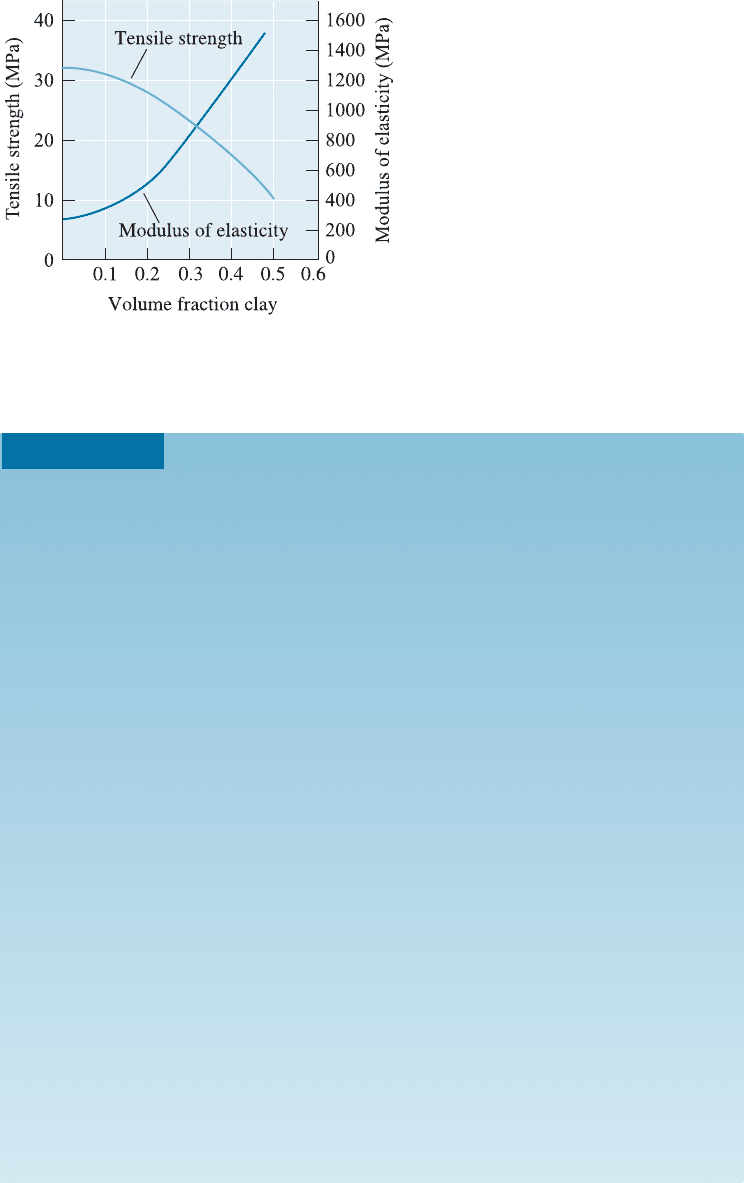
Figure 17-6
The effect of clay on the properties
of polyethylene.
EXAMPLE 17-4
Design of a Particulate Polymer Composite
Design a clay-filled polyethylene composite suitable for injection molding
of inexpensive components. The final part must have a tensile strength of at
least 21 MPa and a modulus of elasticity of at least 552 MPa. Polyethyl-
ene costs approximately $1.1 per kg and clay costs approximately $0.1 per kg.
The density of polyethylene is 0.95 g/cm
3
and that of clay is 2.4 g/cm
3
.
SOLUTION
From Figure 17-6, a volume fraction of clay below 0.35 is required to maintain
a tensile strength greater than 21 MPa, whereas a volume fraction of at least
0.2 is needed for the minimum modulus of elasticity. For lowest cost, we use
the maximum allowable clay, or a volume fraction of 0.35.
In 1000 cm
3
of composite parts, there are 350 cm
3
of clay and 650 cm
3
of
polyethylene in the composite, or:
ð350 cm
3
Þð2:4g=cm
3
Þ¼840 g clay
ð650 cm
3
Þð0:95 g=cm
3
Þ¼617:50 g polyethylene
The cost of materials is:
ð840 g clayÞð$0:1=kgÞ¼$0:084
ð617:50 g PEÞ=ð$1:1=kgÞ¼$0:68
total ¼ $0:764 per 1000 cm
3
Suppose that weight is critical. The composite’s density is:
r
c
¼ð0:35Þð2:4Þþð0:65Þð0:95Þ¼1:46 g=cm
3
17-2 Particulate Composites 551

We may wish to sacrifice some of the economic savings in order to obtain
lighter weight. If we use only 0.2 volume fraction clay, then (using the same
method as above) we find that we need 480 g clay and 760 g polyethylene. The
cost of materials is now:
ð480 g clayÞð$0:1=kgÞ¼$0:048
ð760 g PEÞð$1:1=kgÞ¼$0:836
total ¼ $0:88 per 1000 cm
3
The density of the composite is:
r
c
¼ð0:2Þð2:4Þþð0:8Þð0:95Þ¼1:24 g=cm
3
The material costs about 10% more, but there is a weight savings of more than
10%.
Cast Metal Particulate Composites Aluminum castings containing dispersed SiC par-
ticles for automotive applications, including pistons and connecting rods, represent an
important commercial application for particulate composites (Figure 17-7). With spe-
cial processing, the SiC particles can be wet by the liquid, helping to keep the ceramic
particles from sinking during freezing.
Figure 17-7 Microstructure of an aluminum casting alloy reinforced with silicon carbide
particles. In this case, the reinforcing particles have segregated to interdendritic regions of the
casting (125). (Courtesy of David Kennedy, Lester B. Knight Cost Metals Inc.)
C HA P T E R 1 7 Composites: Teamwork and Synergy in Materials552

17-3 Fiber-Reinforced Composites
Most fiber-reinforced composites provide improved strength, fatigue resistance, Young’s
modulus, and strength-to-weight ratio by incorporating strong, sti¤, but brittle fibers
into a softer, more ductile matrix. The matrix material transmits the force to the fibers,
which carry most of the applied force. The matrix also provides protection for the fiber
surface and minimizes di¤usion of species such as oxygen or moisture that can degrade
the mechanical properties of fibers. The strength of the composite may be high at both
room temperature and elevated temperatures (Figure 17-2).
Many types of reinforcing materials are employed. Straw has been used to
strengthen mud bricks for centuries. Steel-reinforcing bars are introduced into concrete
structures. Glass fibers in a polymer matrix produce fiberglass for transportation and
aerospace applications. Fibers made of boron, carbon, polymers (e.g., aramids, Chapter
16), and ceramics provide exceptional reinforcement in advanced composites based on
matrices of polymers, metals, ceramics, and even intermetallic compounds.
The Rule of Mixtures in Fiber-Reinforced Composites As for particulate composites,
the rule of mixtures always predicts the density of fiber-reinforced composites:
r
c
¼ f
m
r
m
þ f
f
r
f
ð17-2Þ
where the subscripts m and f refer to the matrix and the fiber. Note that f
m
¼ 1 f
f
.
The subscript c refers to the composite.
In addition, the rule of mixtures accurately predicts the electrical and thermal con-
ductivity of fiber-reinforced composites along the fiber direction if the fibers are con-
tinuous and unidirectional:
K
c
¼ f
m
K
m
þ f
f
K
f
ð17-3Þ
s
c
¼ f
m
s
m
þ f
f
s
f
ð17-4Þ
where K is the thermal conductivity and s is the electrical conductivity. Thermal or
electrical energy can be transferred through the composite at a rate that is proportional
to the volume fraction of the conductive material. In a composite with a metal matrix
and ceramic fibers, the bulk of the energy would be transferred through the matrix; in
a composite consisting of a polymer matrix containing metallic fibers, energy would be
transferred through the fibers.
When the fibers are not continuous or unidirectional, the simple rule of mixtures
may not apply. For example, in a metal fiber-polymer matrix composite, electrical
conductivity would be low and would depend on the length of the fibers, the volume
fraction of the fibers, and how often the fibers touch one another. This is expressed
using the concept of connectivity of phases.
Modulus of Elasticity The rule of mixtures is used to predict the modulus of elasticity
when the fibers are continuous and unidirectional. Parallel to the fibers, the modulus of
elasticity may be as high as:
E
c;k
¼ f
m
E
m
þ f
f
E
f
ð17-5Þ
17-3 Fiber-Reinforced Composites 553
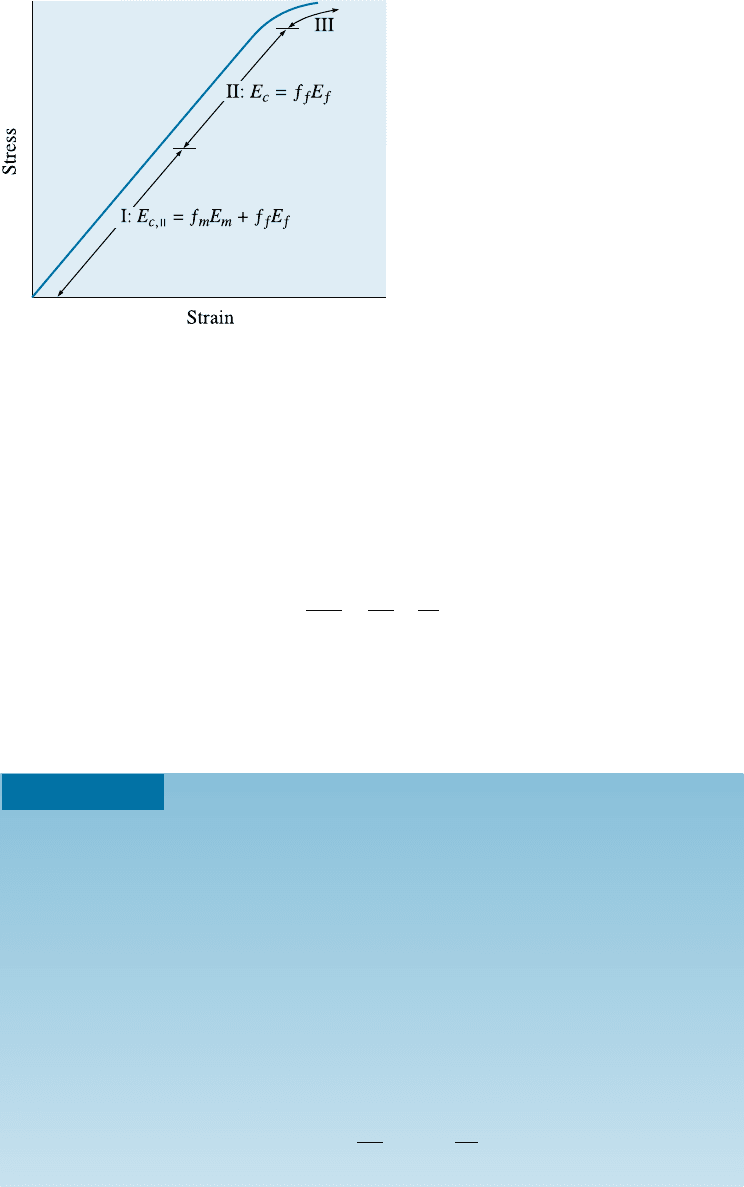
However, when the applied stress is very large, the matrix begins to deform and the
stress-strain curve is no longer linear (Figure 17-8). Since the matrix now contributes
little to the sti¤ness of the composite, the modulus can be approximated by:
E
c;k
¼ f
f
E
f
ð17-6Þ
When the load is applied perpendicular to the fibers, each component of the composite
acts independently of the other. The modulus of the composite is now:
1
E
c;L
¼
f
m
E
m
þ
f
f
E
f
ð17-7Þ
Again, if the fibers are not continuous and unidirectional, the rule of mixtures does not
apply.
The following examples further illustrate these concepts.
Figure 17-8
The stress-strain curve for a fiber-
reinforced composite. At low stresses
(region I), the modulus of elasticity is
given by the rule of mixtures. At higher
stresses (region II), the matrix deforms
and the rule of mixtures is no longer
obeyed.
EXAMPLE 17-5
Rule of Mixtures for Composites: Stress Parallel to Fibers
Derive the rule of mixtures (Equation 17-5) for the modulus of elasticity of a
fiber-reinforced composite when a stress ðsÞ is applied along the axis of the
fibers.
SOLUTION
The total force acting on the composite is the sum of the forces carried by each
constituent:
F
c
¼ F
m
þ F
f
Since F ¼ sA:
s
c
A
c
¼ s
m
A
m
þ s
m
A
f
s
c
¼ s
m
A
m
A
c
þ s
f
A
f
A
c
C HA P T E R 1 7 Composites: Teamwork and Synergy in Materials554

If the fibers have a uniform cross-section, the area fraction equals the volume
fraction f :
s
c
¼ s
m
f
m
þ s
f
f
f
From Hooke’s law, s ¼ e E. Therefore:
E
c;k
e
c
¼ E
m
e
m
f
m
þ E
f
e
f
f
f
If the fibers are rigidly bonded to the matrix, both the fibers and the matrix
must stretch equal amounts (iso-strain conditions):
e
c
¼ e
m
¼ e
f
E
c;k
¼ f
m
E
m
þ f
f
E
f
EXAMPLE 17-6
Modulus of Elasticity for Composites: Stress Perpendicular to
Fibers
Derive the equation for the modulus of elasticity of a fiber-reinforced composite
when a stress is applied perpendicular to the axis of the fiber (Equation 17-7).
SOLUTION
In this example, the strains are no longer equal; instead, the weighted sum of
the strains in each component equals the total strain in the composite, whereas
the stresses in each component are equal (iso-stress conditions):
e
c
¼ f
m
e
m
þ f
f
e
f
s
c
E
c
¼ f
m
s
m
E
m
þ f
f
s
f
E
f
Since s
c
¼ s
m
¼ s
f
:
1
E
c;L
¼
f
m
E
m
þ
f
f
E
f
Strength of Composites The tensile strength of a fiber-reinforced composite (TS
c
)
depends on the bonding between the fibers and the matrix. However, the rule of mix-
tures is sometimes used to approximate the tensile strength of a composite containing
continuous, parallel fibers:
TS
c
¼ f
f
TS
f
þ f
m
s
m
ð17-8Þ
where TS
f
is the tensile strength of the fiber and s
m
is the stress acting on the matrix
when the composite is strained to the point where the fiber fractures. Thus, s
m
is not the
actual tensile strength of the matrix. Other properties, such as ductility, impact proper-
ties, fatigue properties, and creep properties, are di‰cult to predict even for unidirec-
tionally aligned fibers.
17-3 Fiber-Reinforced Composites 555
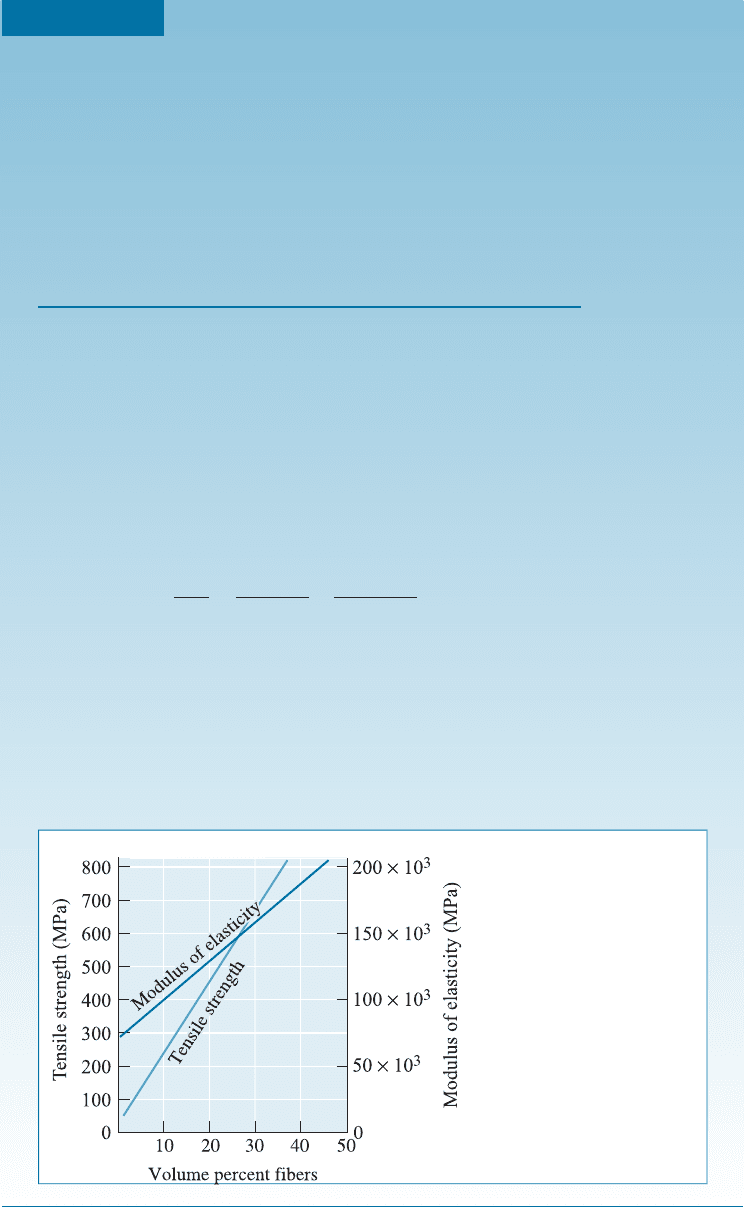
EXAMPLE 17-7 Boron Aluminum Composites
Boron coated with SiC (or Borsic) reinforced aluminum containing 40 vol%
fibers is an important high-temperature, lightweight composite material. Esti-
mate the density, modulus of elasticity, and tensile strength parallel to the fiber
axis. Also estimate the modulus of elasticity perpendicular to the fibers.
SOLUTION
The properties of the individual components are shown below.
Modulus of Tensile
Density Elasticity Strength
Material (g/cm
3
) (MPa) (MPa)
Fibers 2.36 379 10
3
2760
Aluminum 2.70 69 10
3
35
From the rule of mixtures:
r
c
¼ð0:6Þð2:7Þþð0:4Þð2:36Þ¼2:56 g=cm
3
E
c;k
¼ð0:6Þð69 10
3
Þþð0:4Þð379 10
3
Þ¼193 10
3
MPa
TS
c
¼ð0:6Þð35Þþð0:4Þð2760Þ¼1125 MPa
Perpendicular to the fibers:
1
E
c;L
¼
0:6
69 10
3
þ
0:4
379 10
3
¼ 0:00976 10
3
E
c;L
¼ 102:5 10
3
MPa
The actual modulus and strength parallel to the fibers are shown in Figure 17-9.
The calculated modulus of elasticity (193 10
3
MPa) is exactly the same as the
measured modu lus. However, the estimated strength (1125 MPa) is sub-
stantially higher than the actual strength (about 896 MPa). We also note that
the modulus of elasticity is very anisotropic, with the modulus perpendicular to
the fiber being only half the modulus parallel to the fibers.
Figure 17-9
The influence of volume
percent boron-coated SiC
(Borsic) fibers on the
properties of Borsic-
reinforced aluminum
parallel to the fibers
(for Example 17-7).
C HA P T E R 1 7 Composites: Teamwork and Synergy in Materials556

EXAMPLE 17-8 Nylon-Glass Fiber Composites
Glass fibers in nylon provide reinforcement. If the nylon contains 30 vol%
E-glass, what fraction of the applied force is carried by the glass fibers?
SOLUTION
The modulus of elasticity for each component of the composite is:
E
glass
¼ 72:4 10
3
MPa E
nylon
¼ 2:8 10
3
MPa
Both the nylon and the glass fibers have equal strain if bonding is good, so:
e
c
¼ e
m
¼ e
f
e
m
¼
s
m
E
m
¼ e
f
¼
s
f
E
f
s
f
s
m
¼
E
f
E
m
¼
72:4 10
3
2:8 10
3
¼ 25:86
Fraction ¼
F
f
F
f
þ F
m
¼
s
f
A
f
s
f
A
f
þ s
m
A
m
¼
s
f
ð0:3Þ
s
m
ð0:3Þþs
m
ð0:7Þ
¼
0:3
0:3 þ 0:7ðs
m
=s
f
Þ
¼
0:3
0:3 þ 0:7ð1=25:86Þ
¼ 0:92
Almost all of the load is carried by the glass fibers.
17-4 Characteristics of Fiber-Reinforced Composites
Many factors must be considered when designing a fiber-reinforced composite, includ-
ing the length, diameter, orientation, amount, and properties of the fibers; the proper-
ties of the matrix; and the bonding between the fibers and the matrix.
Fiber Length and Diameter Fibers can be short, long, or even continuous. Their
dimensions are often characterized by the aspect ratio defined as l=d, where l is the
fiber length and d is the diameter. Typical fibers have diameters varying from 10 mm
(10 10
4
cm) to 150 mm (150 10
4
cm).
The strength of a composite improves when the aspect ratio is large. Fibers often
fracture because of surface imperfections. Making the diameter as small as possib le
gives the fiber less surface area and, consequently, fewer flaws that might propagate
during processing or under a load. We also prefer long fibers. The ends of a fiber carry
less of the load than the remainder of the fiber; consequently, the fewer the ends, the
higher the load-carrying ability of the fibers (Figure 17-10).
In many fiber-reinforced systems, discontinuous fibers with an aspect ratio greater
than some critical value are used to provide an acceptable compromise between
processing ease and properties. A critical fiber length l
c
, for any given fiber diameter d
can be determined:
l
c
¼
TS
f
d
2t
i
ð17-9Þ
17-4 Chara cteristics of Fiber-Reinforced Composites 557
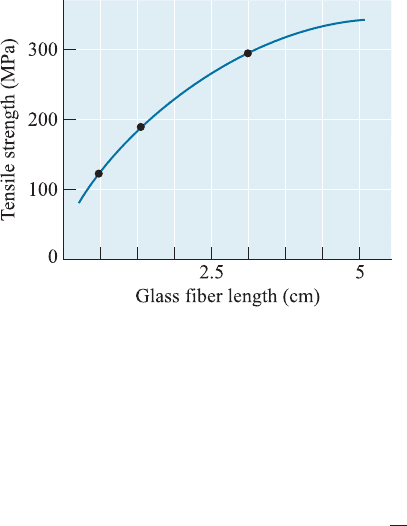
where TS
f
is the strength of the fiber and t
i
is related to the strength of the bond be-
tween the fiber and the matrix, or the stress at which the matrix begins to deform. If the
fiber length l is smaller than l
c
, little reinforcing e¤ect is observed; if l is greater than
about 15l
c
, the fiber behaves almost as if it were continuous. The strength of the com-
posite can be estimated from
s
c
¼ f
f
TS
f
1
l
c
2l
þ f
m
s
m
ð17-10Þ
where s
m
is the stress on the matrix when the fibers break.
Volume Fraction of Fiber A greater volume fraction of fibers increases the strength
and sti¤ness of the composite, as we would expect from the rule of mixtures. However,
the maximum volume fraction is about 80%, beyond which fibers can no longer be
completely surrounded by the matrix.
Orientation of Fibers The reinforcing fibers may be introduced into the matrix in a
number of orientations. Short, randomly oriented fibers having a small aspect ratio—
typical of fiberglass—are easily introduced into the matrix and give relatively isotropic
behavior in the composite.
Long, or even continuous, unidirectional arrangements of fibers produce aniso-
tropic properties, with particularly good strength and sti¤ness parallel to the fibers.
These fibers are often designated as 0
plies, indicating that all of the fibers are aligned
with the direction of the applied stress. However, unidirectional orientations provide
poor properties if the load is perpendicular to the fibers (Figure 17-11).
One of the unique characteristics of fiber-reinforced composites is that their prop-
erties can be tailored to meet di¤erent types of loading conditions. Long, continuous
fibers can be intro duced in several directions within the matrix (Figure 17-12); in
orthogonal arrangements (0
/90
plies), good strength is obtained in two perpendicular
directions. More complicated arrangements (such as 0
/G45
/90
plies) provide re-
inforcement in multiple directions.
Fibers can also be arranged in three-dimensional patterns. In even the simplest
of fabric weaves, the fibers in each individual layer of fabric have some small degree of
orientation in a third direction. Better three-dimensional reinforcement occurs when the
fabric layers are knitted or stitched together. More complicated three-dimensional
weaves (Figure 17-13) can also be used.
Figure 17-10
Increasing the length of chopped
E-glass fibers in an epoxy matrix
increases the strength of the
composite. In this example, the
volume fraction of glass fibers is
about 0.5.
C HA P T E R 1 7 Composites: Teamwork and Synergy in Materials558
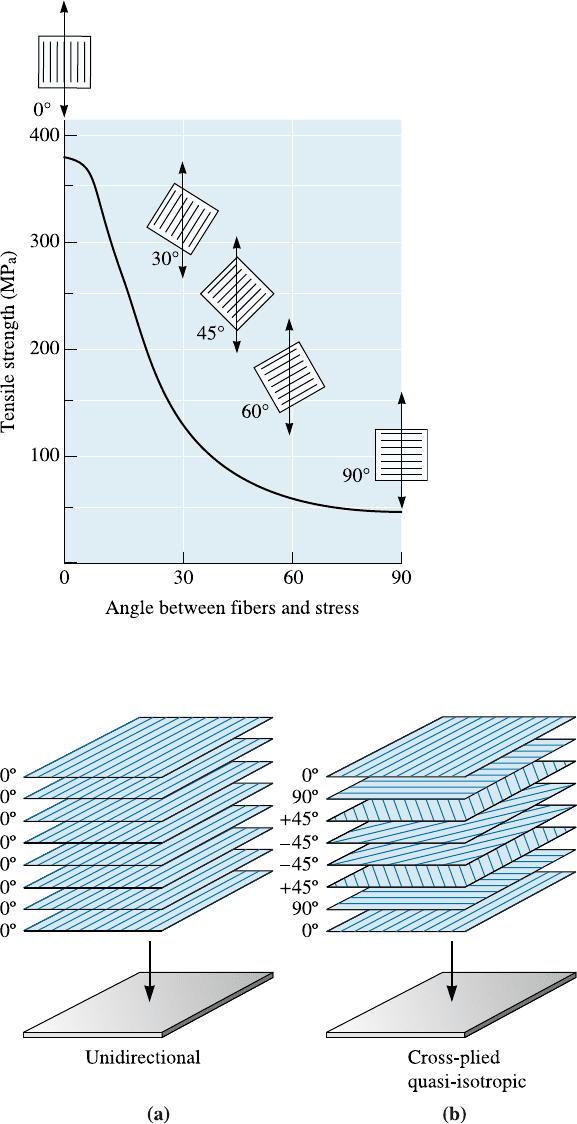
Figure 17-11
Effect of fiber orientation on the
tensile strength of E-glass fiber-
reinforced epoxy composites.
Figure 17-12 (a) Tapes containing aligned fibers can be joined to produce a multi-layered
unidirectional composite structure. (b) Tapes containing aligned fibers can be joined with
different orientations to produce a quasi-isotropic composite. In this case, a 0
/G45
/90
composite is formed.
17-4 Chara cteristics of Fiber-Reinforced Composites 559
